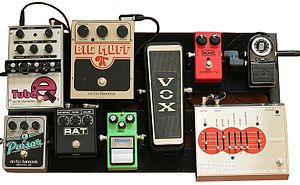
Back وحدة المؤثرات Arabic Ефект педали Bulgarian Efektová jednotka Czech Effektgerät (Musik) German Efektaparato (muziko) Esperanto Unidad de efectos Spanish Procesador de efectos Galician מעבד צליל HE Effetto musicale (chitarra) Italian エフェクター Japanese

An effects unit, effects processor, or effects pedal is an electronic device that alters the sound of a musical instrument or other audio source through audio signal processing.
Common effects include distortion/overdrive, often used with electric guitar in electric blues and rock music; dynamic effects such as volume pedals and compressors, which affect loudness; filters such as wah-wah pedals and graphic equalizers, which modify frequency ranges; modulation effects, such as chorus, flangers and phasers; pitch effects such as pitch shifters; and time effects, such as reverb and delay, which create echoing sounds and emulate the sound of different spaces.[1][2]
Most modern effects use solid-state electronics or digital signal processors. Some effects, particularly older ones such as Leslie speakers and spring reverbs, use mechanical components or vacuum tubes. Effects are often used as stompboxes, typically placed on the floor and controlled with footswitches. They may also be built into guitar amplifiers, instruments (such as the Hammond B-3 organ), tabletop units designed for DJs and record producers, and rackmounts, and are widely used as audio plug-ins in such common formats as VST, AAX, and AU.
Musicians, audio engineers and record producers use effects units during live performances or in the studio, typically with electric guitar, bass guitar, electronic keyboard or electric piano. While effects are most frequently used with electric or electronic instruments, they can be used with any audio source, such as acoustic instruments, drums, and vocals.[3][4]
- ^ "The Art of the Stompbox". The Museum of Making. 2010. Retrieved 13 September 2010.
- ^ "Guitar effects". Trip Atlas. Archived from the original on 8 December 2008. Retrieved 18 September 2010.
- ^ Horne, Greg (2000). Complete Acoustic Guitar Method: Mastering Acoustic Guitar c. Alfred Music. p. 92. ISBN 9781457415043.
- ^ Yakabuski, Jim (2001). Professional Sound Reinforcement Techniques: Tips and Tricks of a Concert Sound Engineer. Hal Leonard. p. 139. ISBN 9781931140065.